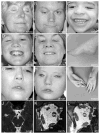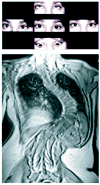The genetic basis of incomitant strabismus: consolidation of the current knowledge of the genetic foundations of disease
- PMID: 24138051
- PMCID: PMC4098966
- DOI: 10.3109/08820538.2013.825288
The genetic basis of incomitant strabismus: consolidation of the current knowledge of the genetic foundations of disease
Abstract
In recent years, our understanding of the genetic foundations of incomitant strabismus has grown significantly. Much new understanding has been gleaned since the concept of congenital cranial dysinnervation disorders (CCDDs) was introduced in 2002, and the genetic basis of CCDDs continues to be elucidated. In this review, we aim to provide an update of the genetic and clinical presentation of these disorders. Disorders reviewed include Duane syndrome (DS), HOXA1 and HOXB1 syndromes, Moebius syndrome, congenital fibrosis of the extraocular muscles (CFEOM), and horizontal gaze palsy with progressive scoliosis (HGPPS).
Figures




Similar articles
-
Diagnostic distinctions and genetic analysis of patients diagnosed with moebius syndrome.Ophthalmology. 2014 Jul;121(7):1461-8. doi: 10.1016/j.ophtha.2014.01.006. Epub 2014 Mar 6. Ophthalmology. 2014. PMID: 24612975 Free PMC article.
-
Clinical and genetic characteristics of Chinese patients with congenital cranial dysinnervation disorders.Orphanet J Rare Dis. 2022 Dec 9;17(1):431. doi: 10.1186/s13023-022-02582-5. Orphanet J Rare Dis. 2022. PMID: 36494820 Free PMC article.
-
[Congenital cranial dysinnervation disorders (CCDD)].Klin Monbl Augenheilkd. 2015 Mar;232(3):275-80. doi: 10.1055/s-0041-100772. Epub 2015 Mar 24. Klin Monbl Augenheilkd. 2015. PMID: 25803556 Review. German.
-
The ECEL1-related strabismus phenotype is consistent with congenital cranial dysinnervation disorder.J AAPOS. 2014 Aug;18(4):362-7. doi: 10.1016/j.jaapos.2014.03.005. J AAPOS. 2014. PMID: 25173900
-
Ocular congenital cranial dysinnervation disorders (CCDDs): insights into axon growth and guidance.Hum Mol Genet. 2017 Aug 1;26(R1):R37-R44. doi: 10.1093/hmg/ddx168. Hum Mol Genet. 2017. PMID: 28459979 Free PMC article. Review.
Cited by
-
Axonal Growth Abnormalities Underlying Ocular Cranial Nerve Disorders.Annu Rev Vis Sci. 2021 Sep 15;7:827-850. doi: 10.1146/annurev-vision-093019-114307. Epub 2021 Jun 3. Annu Rev Vis Sci. 2021. PMID: 34081534 Free PMC article. Review.
-
Candidate Genes in Testing Strategies for Linkage Analysis and Bioinformatic Sorting of Whole Genome Sequencing Data in Three Small Japanese Families with Idiopathic Superior Oblique Muscle Palsy.Int J Mol Sci. 2022 Aug 3;23(15):8626. doi: 10.3390/ijms23158626. Int J Mol Sci. 2022. PMID: 35955756 Free PMC article.
-
Role of Abelson Helper Integration Site 1, Nebulin, and Paired Box 3 Genes in the Development of Nonsyndromic Strabismus in a Series of Iranian Families: Sequence Analysis and Systematic Review of the Genetics of Nonsyndromic Strabismus.J Curr Ophthalmol. 2024 Mar 29;35(3):216-225. doi: 10.4103/joco.joco_53_22. eCollection 2023 Jul-Sep. J Curr Ophthalmol. 2024. PMID: 38681684 Free PMC article. Review.
-
Two unique TUBB3 mutations cause both CFEOM3 and malformations of cortical development.Am J Med Genet A. 2016 Feb;170A(2):297-305. doi: 10.1002/ajmg.a.37362. Epub 2015 Dec 6. Am J Med Genet A. 2016. PMID: 26639658 Free PMC article.
-
Diagnostic distinctions and genetic analysis of patients diagnosed with moebius syndrome.Ophthalmology. 2014 Jul;121(7):1461-8. doi: 10.1016/j.ophtha.2014.01.006. Epub 2014 Mar 6. Ophthalmology. 2014. PMID: 24612975 Free PMC article.
References
-
- Laughlin RC. Congenital fibrosis of the extraocular muscles; a report of six cases. American journal of ophthalmology. 1956 Mar;41(3):432–438. - PubMed
-
- Hotchkiss MG, Miller NR, Clark AW, Green WR. Bilateral Duane’s retraction syndrome. A clinical-pathologic case report. Archives of ophthalmology. 1980 May;98(5):870–874. - PubMed
-
- Miller NR, Kiel SM, Green WR, Clark AW. Unilateral Duane’s retraction syndrome (Type 1) Archives of ophthalmology. 1982 Sep;100(9):1468–1472. - PubMed
-
- Duane A. Congenital Deficiency of Abduction associated with impairment of adduction, retraction movements, contraction of the palpebral fissure and oblique movements of the eye. Archives of ophthalmology. 1905;34:133–150. - PubMed
Publication types
MeSH terms
Substances
Supplementary concepts
Grants and funding
LinkOut - more resources
Full Text Sources
Other Literature Sources
Medical
